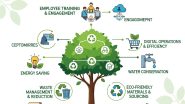In the digital age, the term “website” has become ubiquitous, determining how we access and share information. From personal blogs to multinational corporations, websites are the building blocks of our online presence.
Let's embark on a journey to explore the meaning and origin of the word "website", examine what websites are, examine the different types, and weigh the pros and cons. Finally, we will describe how websites have evolved.
Meaning, Definition, and Origin of “Website”
The term “website” is a compound word combining “web” and “site”. “Web” refers to the World Wide Web, the vast network of interconnected documents and resources accessible via the Internet. The word “site” means a location or place.
Coined in the early days of the Internet, the term "website" emerged to mean a digital space where information could be stored, organized, and accessed.
A website is a collection of web pages, media content, and other digital assets hosted on a web server and accessible through a unique domain name.
These pages are designed using HTML, CSS, and other programming languages, providing a user-friendly interface for individuals and businesses to share information, products, or services with a global audience. To Know Website Meaning in Hindi.
Website Journey:
| Era | Description |
| 1990s | Introduction of basic HTML websites. |
| Early 2000s | Rise of dynamic websites with CSS and JavaScript. |
| Mid-2000s | Emergence of content management systems (CMS) like WordPress. |
| Late 2000s | Growth of social media integration and responsive design. |
| 2010s | Proliferation of mobile-friendly design and the advent of AI. |
| 2020s and Beyond | Continued focus on user experience, accessibility, and AI integration. |
Types of Website
Static and dynamic websites represent two approaches to web content and functionality. The distinction lies in how the content is generated and served to the user.
1. Static Websites:
A static website consists of fixed, unchanging web pages. Each page is coded in HTML and displays the same information to every visitor.
- Characteristics:
- Content remains the same for all users.
- Information is manually coded into each HTML page.
- Limited interactivity and user engagement.
- Best suited for small websites with straightforward content.
- Advantages:
- Simplicity and ease of development.
- Fast loading times as there is no need for server-side processing.
- Cost-effective for small projects.
- Disadvantages:
- Limited interactivity and personalization.
- Updating content requires manual coding.
- Less suitable for dynamic or frequently changing information.
2. Dynamic Websites:
Dynamic websites generate content on the fly, often pulling data from a database. The content displayed can vary based on user interactions, preferences, or real-time data.
- Characteristics:
- Content is generated dynamically at the time of the request.
- Utilizes server-side technologies such as PHP, Python, or Ruby.
- Supports user interaction, personalization, and dynamic content updates.
- Well-suited for large websites with frequently changing information.
- Advantages:
- Allows for user interaction and engagement.
- Easier content management through databases.
- Supports complex features like e-commerce and user accounts.
- Disadvantages:
- Requires more development time and expertise.
- Higher initial costs for hosting and development.
- Potential for slower loading times depending on server resources.
Comparison of Static and Dynamic:
- Flexibility:
- Static: Limited flexibility as content is fixed.
- Dynamic: Highly flexible with the ability to adapt content based on user input or real-time data.
- User Interaction:
- Static: Limited interactivity; content is the same for all users.
- Dynamic: Supports interactive elements, user accounts, and personalized content.
- Updates:
- Static: Manual updates are required for each page.
- Dynamic: Content updates are often automated and managed through a content management system (CMS).
- Scalability:
- Static: Well-suited for small-scale projects.
- Dynamic: Scalable for large, complex websites with evolving content.
The choice between static and dynamic websites depends on the project's requirements, scale, and desired features. Static websites are suitable for simpler projects with fixed content, while dynamic websites offer greater flexibility and interactivity for more complex and dynamic content needs.
Categories of Websites:
- Personal Websites:
- Showcase individual skills, interests, and achievements.
- Commonly used for blogging, portfolio display, or personal branding.
- Business Websites:
- Serve as online storefronts for businesses.
- Include information about products, services, and contact details.
- E-commerce Websites:
- Facilitate online transactions and sales of goods or services.
- Examples include Amazon, eBay, and Shopify.
- Educational Websites:
- Provide learning resources, courses, and academic information.
- Platforms like Coursera and Khan Academy fall into this category.
- News and Media Websites:
- Deliver current events, articles, and multimedia content.
- Examples include CNN, BBC, and The New York Times.
Advantages of Websites:
- Global Reach:
- Websites break geographical barriers, reaching a global audience.
- Accessibility:
- Available 24/7, allowing users to access information at their convenience.
- Cost-Effective Marketing:
- Provides a cost-efficient platform for marketing products and services.
- Interactivity:
- Allows user engagement through comments, forums, and interactive features.
Disadvantages of Websites:
- Technical Issues:
- Websites may face downtime, loading issues, or security vulnerabilities.
- Dependency on the Internet:
- Users need an internet connection to access websites, limiting offline accessibility.
- Security Concerns:
- Websites are susceptible to cyber-attacks and data breaches.
- Maintenance:
- Regular updates and maintenance are required to ensure optimal performance.
Websites have evolved from simple HTML pages to dynamic, interactive platforms that shape our online experiences. Understanding the meaning, types, advantages, and disadvantages of websites is crucial in navigating the digital landscape. As we witness the ongoing journey of websites, it's clear that they will remain integral to our interconnected world, continually adapting to technological advancements and user expectations.




















